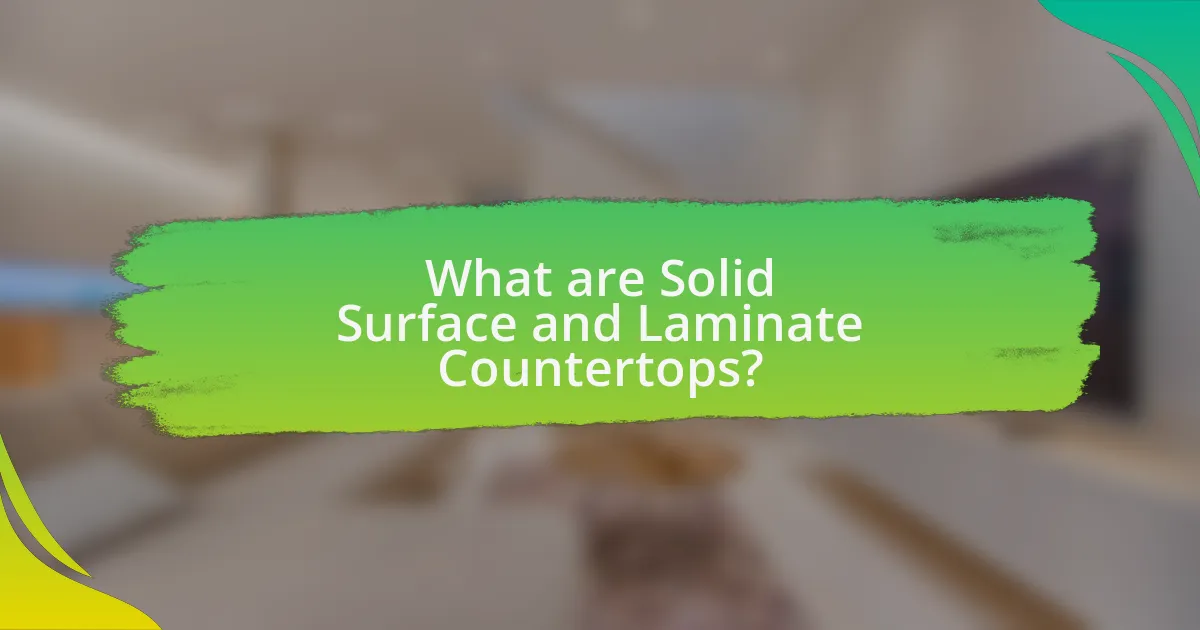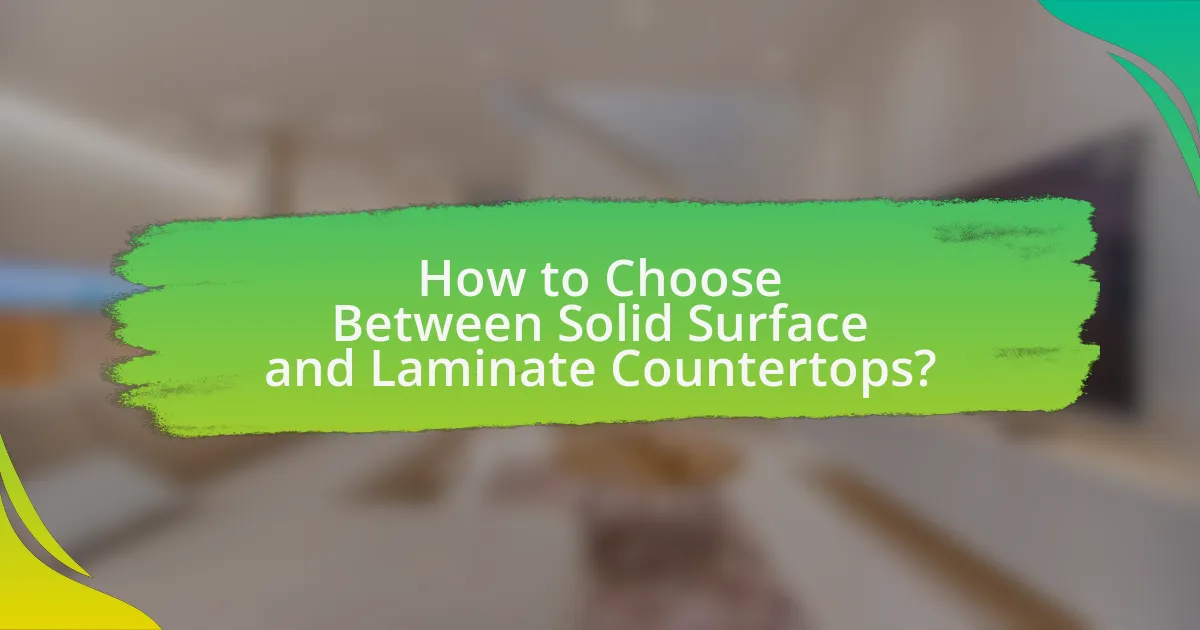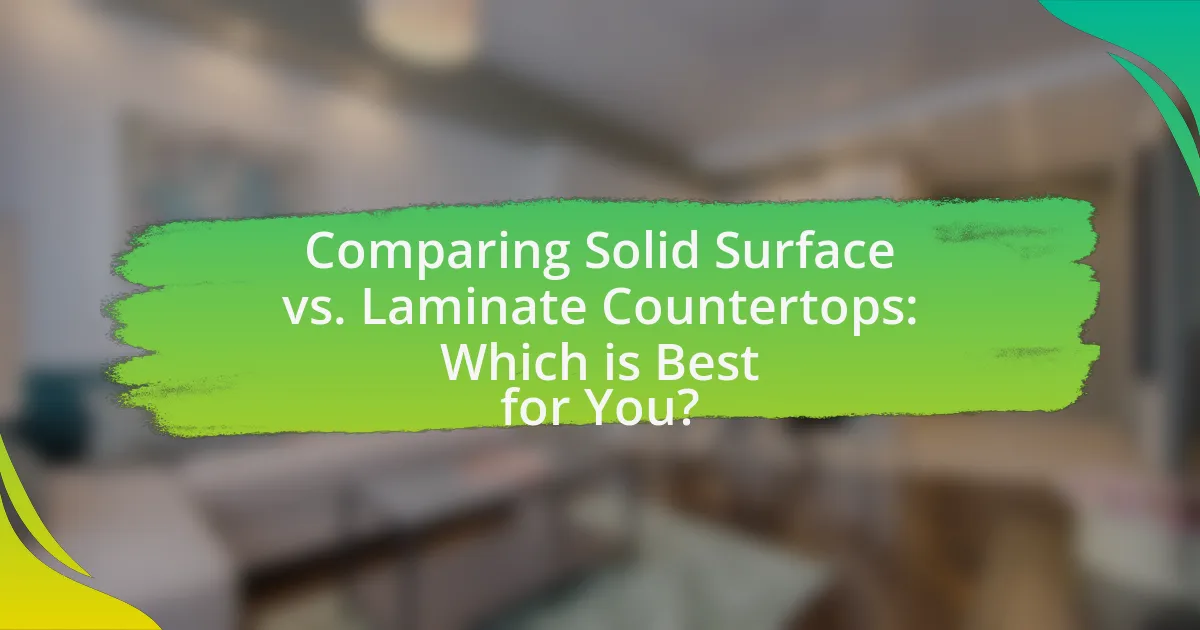The article compares solid surface and laminate countertops, two popular choices for kitchen and bathroom surfaces. Solid surface countertops are man-made materials known for their durability, seamless design, and ease of maintenance, while laminate countertops are cost-effective, lightweight, and available in a wide range of colors and patterns. Key differences include their composition, durability, and repairability, with solid surfaces offering superior resistance to stains and scratches. The article also discusses the materials used in each type, their advantages and disadvantages, and factors to consider when choosing between them, including budget, kitchen style, and specific project needs.
What are Solid Surface and Laminate Countertops?

Solid surface countertops are man-made materials composed of acrylic, polyester, or a combination of both, designed to mimic the appearance of natural stone while offering seamless joints and easy maintenance. Laminate countertops, on the other hand, are made from layers of paper or fabric impregnated with resin, bonded to a particleboard or plywood base, providing a wide range of colors and patterns at a lower cost. Both types of countertops serve as popular choices for kitchen and bathroom surfaces, with solid surfaces offering durability and repairability, while laminates provide affordability and versatility in design.
How do Solid Surface Countertops differ from Laminate Countertops?
Solid surface countertops differ from laminate countertops primarily in their composition and durability. Solid surface countertops are made from a blend of acrylic and polyester materials, resulting in a non-porous, seamless surface that is resistant to stains and scratches. In contrast, laminate countertops consist of a thin layer of decorative paper or plastic bonded to a particleboard core, making them more susceptible to damage from heat and moisture. Additionally, solid surface countertops can be repaired easily by sanding, while laminate surfaces may require complete replacement if damaged.
What materials are used in Solid Surface Countertops?
Solid surface countertops are primarily made from a blend of acrylic or polyester resins and natural minerals, such as aluminum trihydrate. This combination creates a non-porous, durable surface that is resistant to stains and easy to maintain. The use of these materials allows for a wide range of colors and patterns, making solid surface countertops a versatile choice for various applications in kitchens and bathrooms.
What materials are used in Laminate Countertops?
Laminate countertops are primarily made from a combination of particleboard or medium-density fiberboard (MDF) as the core material, topped with layers of decorative paper and resin. The decorative paper is often printed with designs that mimic natural materials like wood or stone, while the resin provides durability and moisture resistance. This construction method allows laminate countertops to be lightweight, cost-effective, and available in a wide variety of styles and colors.
What are the key characteristics of Solid Surface Countertops?
Solid surface countertops are non-porous, durable, and versatile materials commonly used in kitchens and bathrooms. Their non-porous nature prevents the absorption of liquids, making them resistant to stains and easy to clean. Additionally, solid surface countertops can be seamlessly integrated, allowing for a smooth appearance without visible joints. They are also available in a wide range of colors and patterns, providing aesthetic flexibility. Furthermore, solid surface materials can be easily repaired if scratched or damaged, enhancing their longevity. These characteristics make solid surface countertops a popular choice for both residential and commercial applications.
How does durability compare in Solid Surface Countertops?
Solid surface countertops are highly durable, often outperforming laminate in terms of resistance to scratches, stains, and heat. Unlike laminate, which can chip and peel, solid surface materials are non-porous and can be easily repaired if damaged, maintaining their appearance over time. Additionally, solid surface countertops can withstand high temperatures better than laminate, making them suitable for kitchen environments. This durability is supported by their composition, which typically includes acrylic or polyester resins, providing a robust surface that can endure daily wear and tear.
What design options are available for Solid Surface Countertops?
Solid surface countertops offer a variety of design options, including a wide range of colors, patterns, and textures. These countertops can be customized with solid colors, translucent options, and patterns that mimic natural stone, providing versatility for different aesthetic preferences. Additionally, solid surface materials can be seamlessly integrated with sinks and backsplashes, allowing for a cohesive design. The ability to fabricate unique shapes and sizes further enhances their adaptability in various kitchen and bathroom layouts.
What are the key characteristics of Laminate Countertops?
Laminate countertops are characterized by their affordability, versatility, and ease of maintenance. They are made from layers of plastic laminate bonded to a substrate, typically particleboard, which allows for a wide range of colors, patterns, and finishes. This material is resistant to stains and easy to clean, making it suitable for various kitchen and bathroom applications. Additionally, laminate countertops are lightweight and can be installed over existing surfaces, providing a cost-effective renovation option. Their durability is enhanced by a protective layer that resists scratches and impacts, although they can be susceptible to heat damage if not properly cared for.
How does durability compare in Laminate Countertops?
Laminate countertops are generally less durable than solid surface countertops. While laminate is resistant to stains and easy to clean, it is more susceptible to scratches, heat damage, and chipping. According to a study by the National Kitchen and Bath Association, laminate surfaces can last around 10 to 20 years with proper care, whereas solid surfaces can last significantly longer, often exceeding 20 years. This difference in longevity and resistance to damage highlights the comparative durability of laminate countertops.
What design options are available for Laminate Countertops?
Laminate countertops offer a variety of design options, including a wide range of colors, patterns, and textures. These options allow for customization to match different aesthetics, from solid colors to intricate designs that mimic natural materials like wood or stone. Additionally, laminate can be produced with finishes such as matte, gloss, or textured surfaces, enhancing both visual appeal and functionality. The versatility of laminate countertops is supported by the fact that manufacturers provide thousands of designs, making it easy to find a style that fits any kitchen or bathroom decor.
What are the Pros and Cons of Each Type?

Solid surface countertops offer durability and seamless design, while laminate countertops provide affordability and a wide range of styles. The pros of solid surface include resistance to stains and scratches, as well as the ability to be repaired easily. In contrast, the cons involve higher costs and potential for heat damage. Laminate countertops are cost-effective and lightweight, making them easy to install, but they can be less durable and more prone to scratches and moisture damage compared to solid surfaces.
What are the advantages of Solid Surface Countertops?
Solid surface countertops offer several advantages, including durability, ease of maintenance, and design versatility. These countertops are non-porous, which prevents the absorption of stains and bacteria, making them hygienic and easy to clean. Additionally, solid surface materials can be seamlessly integrated, allowing for a continuous appearance without visible seams, enhancing aesthetic appeal. The ability to be easily repaired and refinished further extends their lifespan, as scratches and dents can be sanded out. According to the National Kitchen and Bath Association, solid surface countertops are also available in a wide range of colors and patterns, providing homeowners with numerous design options to suit their preferences.
How do Solid Surface Countertops enhance aesthetics?
Solid surface countertops enhance aesthetics through their seamless design and variety of colors and patterns. The non-porous nature of solid surface materials allows for a smooth, uniform appearance without visible seams, contributing to a sleek and modern look. Additionally, these countertops can be easily customized, offering a wide range of colors and finishes that can complement any interior design style, from contemporary to traditional. The ability to integrate sinks and other features directly into the countertop further enhances the visual appeal, creating a cohesive and polished appearance.
What maintenance requirements are associated with Solid Surface Countertops?
Solid surface countertops require regular cleaning with mild soap and water to maintain their appearance and hygiene. Additionally, they should be periodically polished with a non-abrasive cleaner to restore their shine and remove minor scratches. It is important to avoid harsh chemicals and abrasive pads, as these can damage the surface. Regular maintenance helps preserve the durability and aesthetic appeal of solid surface materials, which are non-porous and resistant to stains, making them easier to care for compared to other countertop materials.
What are the disadvantages of Solid Surface Countertops?
Solid surface countertops have several disadvantages, including susceptibility to scratching, staining, and heat damage. While they are non-porous and easy to clean, their surface can be easily scratched by sharp objects, which may require sanding to repair. Additionally, certain substances, such as red wine or food dyes, can stain the material if not cleaned promptly. Furthermore, solid surface countertops can be damaged by high heat; placing hot pots directly on the surface can lead to warping or discoloration. These factors can impact the longevity and aesthetic appeal of solid surface countertops in comparison to other materials.
How do costs compare with other countertop materials?
Costs for solid surface countertops typically range from $40 to $100 per square foot, while laminate countertops generally cost between $10 and $40 per square foot. This indicates that solid surface materials are significantly more expensive than laminate options. The higher cost of solid surface countertops can be attributed to their durability, aesthetic appeal, and the ability to be seamlessly integrated, which are features that laminate does not offer.
What are the limitations in terms of heat resistance?
Solid surface countertops typically have a heat resistance limit of around 350°F (177°C), while laminate countertops can only withstand temperatures up to approximately 150°F (65°C) before risking damage. Exceeding these temperatures can lead to warping, discoloration, or other forms of degradation in both materials. For instance, placing hot pots or pans directly on laminate surfaces can cause bubbling or peeling of the laminate layer, whereas solid surfaces may only require caution to avoid thermal shock, which can lead to cracking.
What are the advantages of Laminate Countertops?
Laminate countertops offer several advantages, including affordability, versatility in design, and ease of maintenance. Their cost-effectiveness makes them a popular choice for budget-conscious consumers, as they typically range from $10 to $40 per square foot, significantly lower than solid surface materials. Additionally, laminate countertops come in a wide variety of colors, patterns, and finishes, allowing for customization to fit various aesthetic preferences. Maintenance is straightforward, requiring only regular cleaning with mild soap and water, as laminate is resistant to stains and does not require sealing like some other materials. These factors contribute to the overall appeal of laminate countertops in both residential and commercial settings.
How do Laminate Countertops offer affordability?
Laminate countertops offer affordability primarily due to their lower material and manufacturing costs compared to solid surface options. The production process for laminate involves less expensive materials, such as particleboard or MDF, combined with a decorative laminate layer, which significantly reduces overall expenses. Additionally, laminate countertops are easier and quicker to install, leading to lower labor costs. According to the National Kitchen and Bath Association, laminate countertops can cost between $10 to $40 per square foot, while solid surface countertops typically range from $50 to $150 per square foot, highlighting the substantial cost difference.
What maintenance requirements are associated with Laminate Countertops?
Laminate countertops require minimal maintenance, primarily involving regular cleaning with a mild detergent and water. To maintain their appearance, it is essential to avoid abrasive cleaners and harsh chemicals that can damage the surface. Additionally, sealing seams and edges can help prevent moisture infiltration, which is crucial for longevity. Regularly wiping up spills promptly also prevents staining and damage. These practices ensure that laminate countertops remain in good condition over time.
What are the disadvantages of Laminate Countertops?
Laminate countertops have several disadvantages, including susceptibility to scratches, heat damage, and moisture infiltration. These surfaces can easily be scratched by sharp objects, which can compromise their appearance and functionality. Additionally, laminate is not heat-resistant; placing hot pots or pans directly on the surface can cause warping or melting. Furthermore, if water seeps into seams or edges, it can lead to delamination or swelling, reducing the countertop’s lifespan. These factors collectively limit the durability and long-term performance of laminate countertops compared to other materials like solid surfaces.
How do Laminate Countertops perform in terms of durability?
Laminate countertops exhibit moderate durability, making them suitable for various kitchen and bathroom applications. They are resistant to stains and easy to clean, but they can be susceptible to scratches and heat damage. According to the National Kitchen and Bath Association, laminate surfaces can withstand everyday wear and tear, but they require careful handling to avoid deep cuts or burns.
What are the limitations in terms of repairability?
The limitations in terms of repairability for solid surface countertops include the difficulty in repairing deep scratches and significant damage, which may require professional intervention. Unlike laminate countertops, which can often be replaced or patched easily, solid surface materials may need sanding and refinishing to restore their appearance, making repairs more complex and costly. Additionally, the seamless nature of solid surface can complicate repairs, as matching the original finish and color can be challenging.
How to Choose Between Solid Surface and Laminate Countertops?

To choose between solid surface and laminate countertops, consider durability, maintenance, aesthetics, and cost. Solid surface countertops are non-porous, resistant to stains, and can be seamlessly integrated, making them ideal for high-use areas. In contrast, laminate countertops are more affordable and available in a wide range of designs but are less durable and can be damaged by heat and moisture. According to a study by the National Kitchen and Bath Association, solid surface countertops typically last longer than laminate, which can influence long-term value.
What factors should you consider when choosing countertops?
When choosing countertops, consider material durability, maintenance requirements, aesthetic appeal, cost, and environmental impact. Durability is crucial as it affects how well the countertop withstands wear and tear; for example, solid surfaces are generally more resistant to scratches and stains compared to laminate. Maintenance requirements vary, with solid surfaces often needing less upkeep than laminate, which can be more susceptible to damage from heat and moisture. Aesthetic appeal is important for visual harmony in your space, as different materials offer distinct looks. Cost is a significant factor, as solid surfaces typically have a higher price point than laminate, which can influence budget decisions. Lastly, consider the environmental impact of the materials, as some options are more sustainable than others, affecting long-term ecological footprints.
How does your budget influence your choice?
Your budget significantly influences your choice between solid surface and laminate countertops by determining the materials you can afford. Solid surface countertops typically range from $50 to $150 per square foot, while laminate countertops are generally more affordable, costing between $10 to $40 per square foot. This price difference means that a limited budget may lead you to select laminate for its cost-effectiveness, while a more flexible budget could allow for the higher-quality and durable solid surface option. Therefore, the financial constraints directly shape the decision-making process regarding countertop selection.
What role does kitchen style play in your decision?
Kitchen style significantly influences countertop decisions by dictating aesthetic compatibility and functionality. A cohesive kitchen design enhances the overall appeal and usability of the space, making it essential to choose countertops that align with the existing style. For instance, solid surface countertops often complement modern and minimalist designs due to their seamless appearance, while laminate countertops may suit more traditional or eclectic styles due to their variety of patterns and colors. Research indicates that 70% of homeowners prioritize design coherence when selecting kitchen materials, underscoring the importance of kitchen style in decision-making.
What are the best use cases for Solid Surface Countertops?
The best use cases for solid surface countertops include residential kitchens, commercial kitchens, healthcare facilities, and educational institutions. In residential kitchens, solid surface countertops provide a seamless, non-porous surface that is easy to clean and maintain, making them ideal for food preparation. In commercial kitchens, their durability and resistance to stains and scratches support high-volume use. Healthcare facilities benefit from solid surface countertops due to their hygienic properties, as they can be easily sanitized and do not harbor bacteria. Educational institutions utilize solid surface countertops in laboratories and classrooms for their durability and versatility, accommodating various activities and materials.
In which environments do Solid Surface Countertops excel?
Solid surface countertops excel in environments that require durability, hygiene, and aesthetic appeal, such as kitchens, bathrooms, and commercial spaces. These countertops are non-porous, making them resistant to stains and easy to clean, which is essential in food preparation areas and healthcare facilities. Additionally, their seamless design minimizes the risk of bacteria buildup, enhancing sanitation in environments like restaurants and hospitals. The versatility in design allows for integration into various styles, making them suitable for both residential and commercial applications.
What types of projects benefit most from Solid Surface materials?
Solid Surface materials are particularly beneficial for projects that require durability, aesthetic versatility, and seamless design, such as kitchen countertops, bathroom vanities, and commercial spaces. These materials are non-porous, making them resistant to stains and easy to clean, which is essential in high-traffic areas. Additionally, their ability to be molded into various shapes allows for custom designs that enhance both functionality and visual appeal. The seamless joints of Solid Surface materials eliminate crevices where bacteria can thrive, making them ideal for healthcare facilities and food service environments.
What are the best use cases for Laminate Countertops?
Laminate countertops are best used in budget-friendly kitchen and bathroom renovations, where cost-effectiveness and aesthetic variety are priorities. They are ideal for residential spaces, particularly in rental properties or homes with high traffic, due to their resistance to scratches and stains. Additionally, laminate countertops are suitable for DIY projects because of their lightweight nature and ease of installation. Their wide range of colors and patterns allows for customization, making them a popular choice for modern and contemporary designs.
In which environments do Laminate Countertops excel?
Laminate countertops excel in residential kitchens and bathrooms due to their affordability, durability, and ease of maintenance. These surfaces are resistant to stains and scratches, making them ideal for high-traffic areas where spills and wear are common. Additionally, laminate countertops are available in a wide variety of colors and patterns, allowing for versatile design options that can complement various interior styles. Their non-porous nature also prevents the growth of bacteria, enhancing hygiene in food preparation areas.
What types of projects benefit most from Laminate materials?
Laminate materials are most beneficial for budget-conscious projects, such as residential kitchen and bathroom countertops, as well as commercial surfaces. These materials offer a cost-effective solution while providing a wide range of designs and finishes that mimic more expensive materials like wood or stone. Additionally, laminate is lightweight and easy to install, making it ideal for DIY projects and renovations. Its durability against scratches and stains further supports its use in high-traffic areas, ensuring longevity and ease of maintenance.
What tips can help you make the best countertop choice?
To make the best countertop choice, consider factors such as durability, maintenance, aesthetics, and cost. Solid surface countertops offer seamless designs and are easy to repair, while laminate countertops are budget-friendly and come in various styles. Research indicates that solid surfaces are more resistant to scratches and stains, making them ideal for high-traffic areas. In contrast, laminate is lighter and easier to install, which can reduce labor costs. Evaluating these aspects will help you select the countertop that best fits your needs and lifestyle.
How can you assess your specific needs and preferences?
To assess your specific needs and preferences regarding countertops, start by evaluating your lifestyle, cooking habits, and aesthetic desires. For instance, if you frequently cook and require a durable surface, solid surface countertops may be more suitable due to their resistance to stains and scratches. Conversely, if budget constraints are a priority, laminate countertops offer a cost-effective solution while still providing a variety of designs. Additionally, consider maintenance requirements; solid surfaces are easier to repair, while laminate may require more careful handling to avoid damage. By analyzing these factors, you can make an informed decision that aligns with your practical needs and personal style.
What resources are available for countertop comparisons?
Resources available for countertop comparisons include online guides, product reviews, and comparison websites. Websites like Consumer Reports provide detailed evaluations of various countertop materials, including solid surface and laminate options, highlighting their durability, maintenance, and cost. Additionally, home improvement retailers often offer comparison charts that outline the pros and cons of different countertop types, aiding consumers in making informed decisions. These resources are essential for understanding the differences and benefits of solid surface versus laminate countertops.



